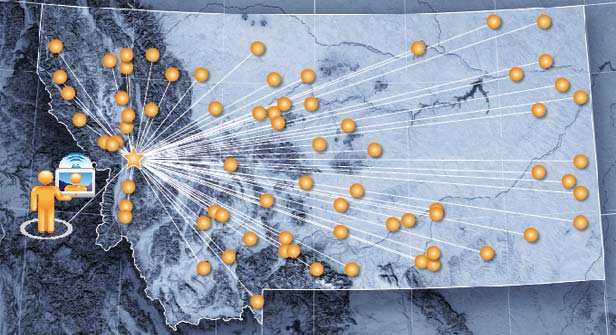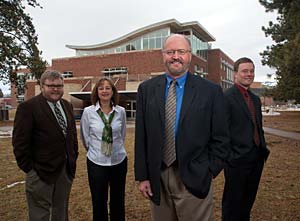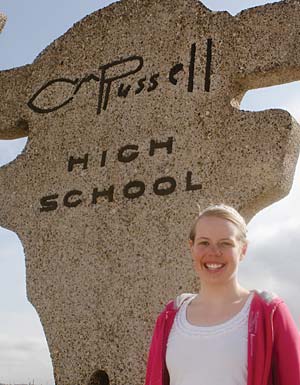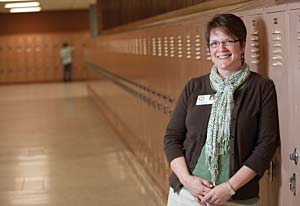

The Magazine of The University of Montana
A Big Sky Classroom
The Montana Digital Academy Gives Students Across the State the Chance to Succeed
By Erika Fredrickson

Based on the third floor of UM’s Phyllis J. Washington College of Education and Human Sciences, Montana Digital Academy serves nearly 2,000 students in 137 schools across the state.
It wasn’t long ago that answering machines were the norm and cellphones a novelty. It wasn’t even that long ago that e-mail became commonplace. Texting? Some of us only started doing that in the past few years. Such rapid development means new generations aren’t just learning technological literacy in a world of evolving communication and information tools—they’re born into it. And virtual education is a part of that evolution.
One of the newest additions to virtual education in the state is the Montana Digital Academy [MTDA], which launched last fall. The program, funded by the 2009 Montana Legislature, serves up a buffet of forty-five different classes that run the gamut from basics such as Algebra I to electives like Digital Photography, with opportunities for dual credit for college. The free courses are delivered through the Internet, twenty-four hours a day, seven days a week, to registered students from all corners of the state—creating a virtual classroom of students from Missoula to Sidney, Havre to Billings, and everywhere in between.
The program now serves high school students and some middle schoolers, though the goal is to eventually provide a full K-12 selection. Nearly 2,000 students from 137 schools of all sizes enrolled this spring semester, and seventy certified teachers in thirty different school districts teach the courses.
What makes MTDA unique is that it doesn’t just apply to one kind of student. It can help gifted or struggling students and those with scheduling issues. Equally important is the fact the MTDA links classrooms to future educators. Though the program’s aim is K-12 students, it’s headquartered at The University of Montana, which opens up opportunities for those working toward an education degree to add one more tool to their teaching toolbox.

MTDA Director Robert Currie, second from right, moved to Montana from Michigan to launch the program. Jason Neiffer, left, is the curriculum director, Rayleen Hicks is the administrative assistant, and Ryan Schrenk, right, is the instructional program coordinator.
Photo by Todd Goodrich
Growing a Virtual Classroom
Robert Currie isn’t really bragging when he says he has all the credentials to run a virtual program. As MTDA executive director, Currie is a career educator from Michigan who’s worked in three different school districts as a superintendent of schools, principal, assistant superintendent for curriculum, a teacher, a counselor, and a coach. Most recently, Currie spent six and a half years as executive director of the Michigan Virtual School. It was his role in the virtual school network that led him to hear about Montana’s plans to start a program. By that time, he’d taken Michigan’s virtual school enrollment of about 5,000 to nearly 15,000.
“That really gave me the foundation to be able to come here and lay out the framework,” Currie says. “I was selected to start up the initial program, and I arrived here January 4, 2010. Jason Neiffer [the curriculum director] and I worked through all of the start-up activities—organizing and training, the selection of materials.”
The curriculum blends required courses like English, math, science, and social studies with a slew of world languages, plus electives such as Oceanography, Web Design, and Photography. Furthermore, they built specialized classes specific to the state, including a Montana history course and a Native American studies course. The variety has helped fill in gaps.
“We have some very unique students, some with specific health issues that have severely limited their ability to attend school,” Currie says. “Students involved in Alpine skiing, students traveling with the rodeo competitions—we had a junior hockey player working toward the Olympics.”
Those with learning disabilities also have benefited, Currie says. One kid with Asperger’s syndrome was reluctant to go to school and be subjected to peer scrutiny.
“That student is involved in one of our courses and doing very well learning to communicate, critique others’ work, and be critiqued,” says Currie. “Those kinds of skills are pretty important, and that particular course is making a difference in the student’s life, building confidence.”
Despite the fact that technology seems to come easier to younger generations, Currie says online learning isn’t necessarily a breeze for the tech savvy. As MTDA students work in a statewide classroom, “netiquette” becomes an important aspect of online learning.
“When you’re communicating in an online course, just as you’re communicating in the classroom, there are certain standards,” Currie says. “It’s not going to be the same communication that you would text to your friend or use on Facebook. Learning what’s appropriate, learning how to be part of an online discussion for the first time, is challenging.”
One thing that helps students with online learning is MTDA’s blending of education with gaming. In one Spanish class, for instance, students can create an avatar that navigates the course through games, such as vocabulary challenges. As students succeed, they earn virtual money, which they can use for online shopping to enhance their avatar. It helps spur some competitiveness that results in learning.
“A student may be doing a drill in Spanish but it doesn’t feel quite like sitting there with flashcards,” says Currie. “We’ve had kids in the past that start to have these rivalries about how cool their avatar is, or how much money they’ve made. That makes it a fun experience and something different from what they’ve ever experienced before.”
Learning on the slopes

Photo courtesy of Lacey family

MTDA allows CMR student Darby Lacey to balance being a successful student and a top-notch Alpine ski racer.
Photo by Todd Goodrich
During the winter, Darby Lacey’s typical day is unlike most kids’ her age. The sixteen-year-old attends C.M. Russell High School in Great Falls, but often enough she’s out on the road competing in United States Ski and Snowboard Association or International Ski Federation races anywhere from Sun Valley in Idaho to Nakiska in Alberta, Canada. She’s skied since age two and a half and competed for the past eight years of her life. Each year during the snow season, that can require several weeks’ worth of school absences. Even for a student who maintains a 4.0 grade-point average, which Lacey does, it’s not easy to keep up.
“So far this semester—and we’re not even a quarter of the way done with it—I’ve missed twelve days,” says Lacey. “We’re only supposed to miss ten, but as long as you keep your grades up, it’s O.K.”
A typical day includes being on the slopes by six in the morning to do practice inspections of the ski runs, followed by a couple of competitions. The end of the day requires several ski waxings, dinner, and a recovery workout.
“It gets stressful because with ski racing you have so much to do,” Lacey says. “Some nights I’m not done until nine, and then I don’t have a lot of time for homework.”
Until recently, Lacey improvised. She worked on homework in the car, or did it ahead of time to free herself up for skiing. She’s had supportive teachers, she says, and some sent her class notes. When it comes to class discussions, however, it’s easy for Lacey to miss out. This year she’s enrolled in an Advanced Placement history class through MTDA that allows her to engage in discussions with other students on her own time, even when she’s competing on the road.
“At school [AP history] is a really discussion-based class and you can’t really make up classroom discussions, so we replicate that through online discussion,” says Lacey. “If you’re not a motivated person, it doesn’t really work, but I like it because I don’t have to waste time with a teacher disciplining kids or kids who didn’t get the homework done. It’s just me getting what I need to get done when I want to get it done.”
Different strokes

Susan Quinn, associate principal at C.M. Russell High School in Great Falls, says MTDA helps all different types of students succeed in school. She also teaches a psychology course in the program.
Photo by Todd Goodrich
One student at CMR was truant for two and a half months. Susan Quinn, associate principal at the high school, says it was a circular problem. His mother would drop him off at school, and he would take off. The school would call the mother, but then it would happen all over again. There were problems at school, there were problems at home, but even with truancy laws it wasn’t easy to force the student to go to class.
“We finally got ahold of him,” says Quinn. “I said to him, ‘What is it about school that you don’t like?’ And he said, ‘I don’t like anything.’ And so I asked him if I could remove all the going from class to class and just have him at a computer learning, would he do that? And he said, ‘Yeah, I’d do that.’”
The typical online learner is often pegged as a gifted kid, Quinn says, a kid who already is motivated in school and just needs another step up or, like Lacey, needs another option to facilitate an already accelerated lifestyle. In this instance, however, MTDA serves as an alternative to someone who is academically capable but who dislikes all the other aspects of school enough to run away from it. The student now sits for four hours a day with help from the high school media specialist, ear buds in—learning.
| “ | If you think about the problems…leading to high school dropout rates, the Digital Academy alone will address many of them for Montana. | ” |
“It’s such a nice story in that there are options,” says Quinn. “Some kids recognize the drama that goes on in school, and they just don’t thrive on it. This kid was just really struggling, and here he sits and does MTDA classes every day.”
Educators like Quinn see online learning as vital for students who need an alternative to classroom learning, especially in the context of being in a generation brought up on visual stimulation. The Great Falls public schools have their own suite of online classes, but those only cover classes that can be filled by local students. If one student in Great Falls wants to take Chinese, for instance, it wouldn’t be economical to offer it. The statewide net cast by MTDA, however, can fill more obscure virtual classroom needs.
The program also gives teachers a chance to diversify. In addition to her duties as associate principal, Quinn, a former history teacher, is now back teaching—as a psychology instructor for MTDA.
“We looked at Montana Digital Academy as another way to kind of let online learning go viral,” she says. “It helps kids get a little bit of a taste for it so they know how it works and so they see they can be successful doing it.”
Teaching the teachers
Roberta “Bobbie” Evans sees MTDA as a way to prepare the next generation of educators for the real world—which includes virtual environments. As dean of UM’s Phyllis J. Washington College of Education and Human Sciences, Evans is interested in all the cutting-edge tools that will put UM students at the head of the pack when it comes to getting jobs as teachers, counselors, and school administrators.
“Teachers leave education programs with a broad repertoire of approaches to teaching,” Evans says. “They have to meet so many different learning styles and needs in individual students, and this experience with MTDA will give teachers a whole new portfolio of skills to share.”
Evans says that education programs in Montana have invested heavily in online technology during the past eight years, and MTDA is part of that endeavor. It’s another approach for teachers when classroom environments aren’t quite cutting it, when students might see dropping out as the only option.
“You can fill in as a student begins to struggle or needs to repeat a class,” Evans says. “That’s part of that credit-recovery mission. If you think about the problems that are pretty complex leading to high school dropout rates, the Digital Academy alone will address many of them for Montana.”
MTDA staff likely will offer pre-service teachers preparation courses in online teaching by autumn. But UM isn’t the only potential beneficiary of MTDA when it comes to college-level education studies. Currie says that because it’s a statewide program, it should help all educators who are going out into the field.
“Some of this is still pretty developmental, and naturally by our location [at UM] those discussions go on regularly here,” he says. “But there are a lot of professional development opportunities, and we would be willing to offer that kind of program to other teacher prep schools in the state. I think that that’s going to really put university graduates at an advantage if they have that skill in their toolbox.”
Evans agrees, saying that advantage will only enhance the positive effect on kids. Given a good teacher, she says, the forum of a statewide classroom can flourish.
“When they teach across the state and augment the numbers of students with these cross-pollinations, kids will make connections,” she says. “It’s great linkage. And a great teacher will always foster great camaraderie—and now you’ve got that across the whole state.”

 Email Article
Email Article 
